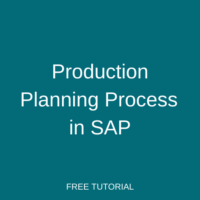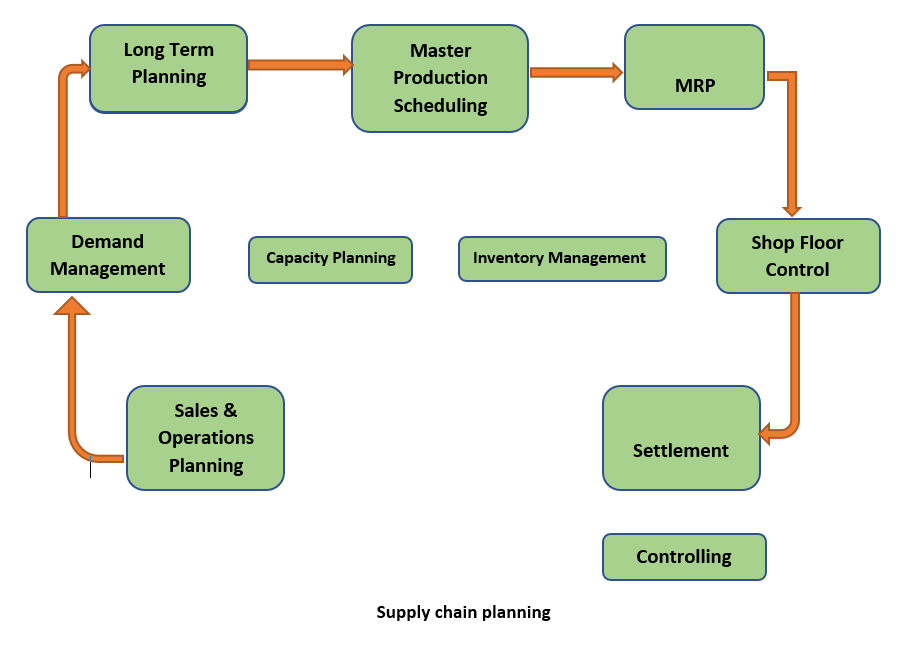 SAP is an ERP system that provides functionalities to manage the entire business process. The Production Planning Process in SAP is one of the essential business processes which is vital when it comes to manufacturing/assembling organizations. Production planning is a concept that is designed to manage the supply chain of the organization. SAP Production Planning (PP) module provides key functionalities to help organizations manage their supply chain.
SAP is an ERP system that provides functionalities to manage the entire business process. The Production Planning Process in SAP is one of the essential business processes which is vital when it comes to manufacturing/assembling organizations. Production planning is a concept that is designed to manage the supply chain of the organization. SAP Production Planning (PP) module provides key functionalities to help organizations manage their supply chain.
Production Planning Process in SAP
Supply chain management focuses on the management of the flow of goods and how the raw materials are transformed into finished products. Below are the key steps that are handled through the production planning process in SAP:
- Sales and Operations Planning (SOP)
- Demand Management
- Long-Term Planning
- Master Production Scheduling
- Material Requirement Planning
- Shop Floor Control
- Settlement
Capacity planning and inventory management are used throughout this cycle.

Sales and Operations Planning
The Sales and Operation Planning (SOP) component in SAP manages sales, production, and other supply chain targets of the organization. This is done through a planning tool that uses historical and current data to set up the future supply chain targets in the system.
Information passed through sales and operations planning is passed into Master Production Scheduling (MPS) and Material Requirement Planning (MRP). SOP is also connected with profitability analysis, cost center accounting, and activity-based costing. There are two main planning methods available in SOP and we can customize further methods based on the requirement.
- Consistent planning
- Level-by-level planning
Demand Management
Demand management in production planning is handled through the planning strategy. Planning strategy determines the method in which a product is manufactured. The main demand management method is planned independent requirements (PIR). The PIR creates demand in the system, and it can be used in a make-to-stock (MTS) planning strategy.
The MTS is a planning strategy where the production is done without any relationship to a sales order. Manufactured components will be stocked in a warehouse and when the customer demand arises, the stock will be issued against a sales order. Two planning strategies are mainly used in an MTS scenario. The first is strategy is 10, which only considers the PIR quantity. The second strategy is 40, which considers both PIR and sales orders. When sales orders are raised, PIR quantity is reduced during the MRP run.
A make-to-order (MTO) planning strategy is based on sales orders. Production does not start until the customer sales orders are placed in the system. Production and inventory are managed with the sales order link and the production process can be tracked using the sales order.
Long-Term Planning
Long-term planning is used to check the future demands of materials based on the bill of material (BOM). Long-term planning can be carried out in simulation mode. It will check the capacity availabilities, material forecast, and delivery timelines, and if the requirements can be fulfilled, simulation can be transferred into an operational mode.
Long-term planning can be executed based on an existing production BOM. It is also possible to define BOM and routing specifically for long-term planning.
Master Production Scheduling
Master production scheduling (MPS) enables the planning of critical materials of an organization with special tools. MPS increases material availability, reduces storage costs, and increases planning stability. MPS materials are planned independently and will not be considered in the regular MRP runs.
Material Requirement Planning
Material requirement planning (MRP) is the heart of the production planning process. MRP matches the demand and the supply and proposes the best methods for executing the production process. The output of the MRP run is the procurement proposals.
There are two main procurement proposals in SAP. These are the plan order and purchase requisitions.
Plan order is generated through MRP for materials that are produced in-house. Plan orders are converted into production orders when the manufacturing starts. The second procurement proposal which MRP generates is the purchase requisitions. Purchase requisitions are generated for materials that are procured from external parties. These include mainly the raw materials. Purchase requisitions are converted into purchase orders.
When the MRP is executed, the BOM will be exploded. Based on the planning strategy of the materials, a procurement proposal will be generated. There are three processing keys used for MRP.
- NETCH – net change planning considers materials that have undergone an MRP relevant change after the last MRP run. An example of MRP relevant change is the increase of stock in the system.
- NETPL – net change in the planning horizon is similar to NETCH but it works for a defined planning period.
- NEUPL – regenerative planning executes MRP for all the materials in the system, irrespective of MRP relevant changes.
Shop Floor Control
Shop floor control in production planning is mainly about executing the production functions within the shop floor. Shop floor control determines which materials need to be produced, the quantities to be produced, and the locations in which the materials are to be produced. Shop floor control uses production planning master data such as BOM, routing, work center, and production versions when executing the shop floor activities.
Shop floor activities are based on a production order or a process order. Production/process order has the quantities to be produced, scheduled dates, routing sequence, work centers, and materials that are consumed during the production. Monitoring and controlling the shop floor activities are essential for the supply chain management.
Capacity Planning
Capacity planning is essential for the supply chain management process. Demand vs supply capability is based on the available manufacturing capacity. The manufacturing capacity is dependent on the capacity of the work centers. A work center can be a person, a group of people, or a machine.
For each work center, individual capacities can be defined. Capacities are generally defined in minutes or hours. Based on the work center capacity and the standard values of the product, schedule dates will be determined for production. Scheduling determines when the production can start and when it can end based on the work center capacity and other defined constraints.
Accurate capacity planning is required to achieve a seamless production planning process.
Inventory Management
Inventory management deals with the management of material stocks on a quantity and value basis. Documenting goods movements and carrying out physical inventory are also important functions of inventory management.
Inventory management also provides the capability to handle special stocks like sales order stocks and consignment stocks. When it comes to production planning, managing the material stocks and executing goods movements are essential activities on the shop floor. Therefore, inventory management is used throughout the production process.
Settlement
Once the production is complete, settlement runs are carried out to identify and evaluate the variances. Production orders will be technically completed, and this marks the completion of the production planning process.
—
Did you like this tutorial? Have any questions or comments? We would love to hear your feedback in the comments section below. It’d be a big help for us, and hopefully, it’s something we can address for you in the improvement of our free SAP PP tutorials.
Navigation Links
Go to the next lesson: Demand Management in SAP
Go to the previous lesson: SAP PP Overview
Go to overview of the course: SAP PP Training

Hi, I love your website.
The content is excellent. I took a SAP PP course with Henry Harvin and the instructor was terrible. We where not provided with any documentation content at all. So, now I have to find a way to learn the module on my own.
The only thing that I would add to your training is pictures of the screens from SAP where this training subject takes place. This way we can put the concept with the action area in SAP.
My goal is to be SAP PP Certified.
Thank you,
Elsy Escobar
Hi ,I leaned lot of things from this SAP PP tutorial.
Nicely described